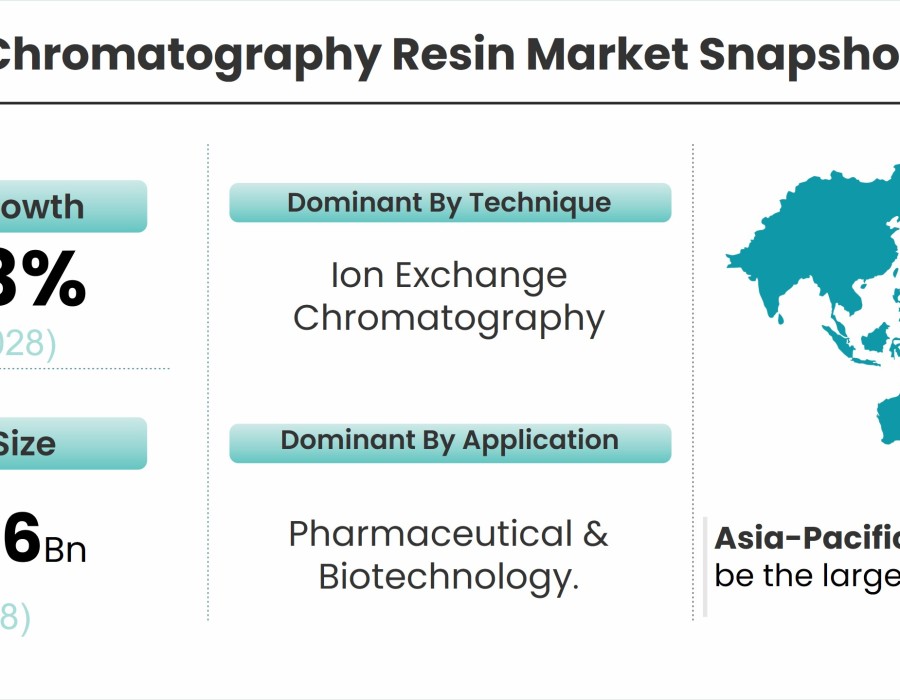According to Stratview Research, the chromatography resin market was estimated at USD 2.68 billion in 2022 and is likely to grow at a CAGR of 8.03% during 2022-2028 to reach USD 4.26 billion in 2028.
Chromatography, a versatile separation technique, is a cornerstone in the fields of chemistry, biotechnology, pharmaceuticals, and beyond. At its heart lies the crucial component known as chromatography resin. This resin is the unsung hero of separation science, facilitating the separation and purification of a vast array of compounds with precision and efficiency. In this article, we delve into the science behind chromatography resin, shedding light on its composition, mechanisms, and the diverse applications that rely on its unique properties.
Composition of Chromatography Resin
Chromatography resins are typically composed of small, porous beads made from various materials, including agarose, cellulose, dextran, and polymethacrylate. These beads serve as the solid support matrix upon which chromatographic separations take place.
Functional Groups
The magic of chromatography resin lies in its functional groups. These are specific chemical moieties grafted onto the surface of the resin beads. Functional groups can vary significantly, allowing chromatography resin to interact selectively with target compounds. Some common functional groups include:
Ion Exchange Groups: These functional groups can be positively charged (cation exchange) or negatively charged (anion exchange). They attract and bind compounds with opposite charges, making ion exchange chromatography a valuable tool for purifying proteins, nucleic acids, and other charged molecules.
Affinity Ligands: Affinity chromatography resins have ligands that bind specifically to target molecules based on their biological or chemical properties. This is highly useful for purifying proteins, antibodies, and other biomolecules.
Hydrophobic Groups: Hydrophobic interaction chromatography (HIC) relies on hydrophobic groups that interact with non-polar regions of molecules. This technique is commonly used in the purification of proteins, particularly those sensitive to harsh conditions.
Size Exclusion Groups: Size exclusion chromatography (SEC) resins have pores of varying sizes that separate molecules based on their size and shape. This method is valuable for separating polymers, biomolecules, and more.
Chromatography Mechanisms
Chromatography resins leverage different mechanisms to separate compounds:
Adsorption: In adsorption chromatography, molecules adhere to the resin surface based on their interactions with the functional groups. Weaker interactions result in faster elution, while stronger interactions lead to longer retention.
Partitioning: Partitioning chromatography involves the distribution of compounds between a mobile phase (e.g., a liquid) and a stationary phase (the resin beads). Compounds with higher affinity for the stationary phase spend more time within it and elute later.
Exclusion: In size exclusion chromatography, molecules are separated based on their ability to enter pores within the resin beads. Larger molecules elute first, while smaller ones navigate deeper into the pores and elute later.
Applications of Chromatography Resin
Chromatography resin finds application in various industries:
Biopharmaceuticals: The purification of therapeutic proteins, monoclonal antibodies, and vaccines is reliant on chromatography resins.
Pharmaceuticals: Drug discovery, quality control, and formulation processes frequently involve chromatography resin.
Biotechnology: Chromatography resin plays a vital role in DNA and RNA purification, enzyme isolation, and cell culture.
Food and Beverage: It is used for quality control, flavor enhancement, and the removal of impurities.
Environmental Monitoring: Chromatography resin assists in the analysis of pollutants and contaminants in air, water, and soil.
Advancements and Future Trends
The world of chromatography resin is ever-evolving. Recent advancements include the development of novel resins with enhanced selectivity and capacity, as well as the pursuit of sustainable and environmentally friendly options. As industries continue to demand higher purity and efficiency, chromatography resin will remain at the forefront of scientific innovation, serving as an indispensable tool for separation science.
Conclusion
Chromatography resin, with its diverse functional groups and mechanisms, is the unsung hero of separation science. Its role in purifying and separating complex mixtures of compounds is indispensable across various industries. As technology advances, we can expect chromatography resins to continue to evolve, enabling scientists to achieve new levels of precision, purity, and efficiency in their work. This versatile material exemplifies the intricate synergy between chemistry, biology, and engineering that drives scientific progress forward.






Comments